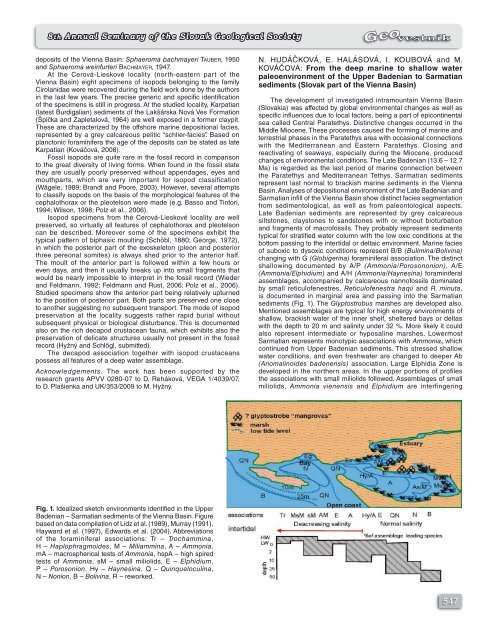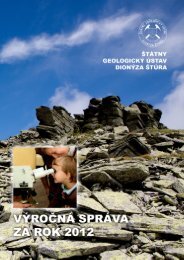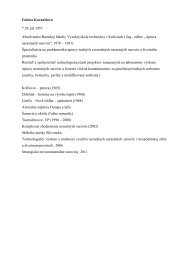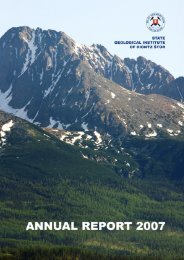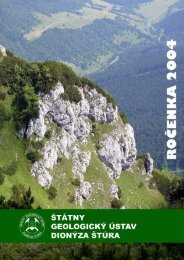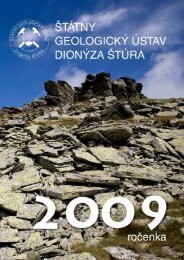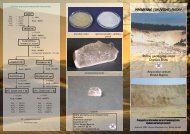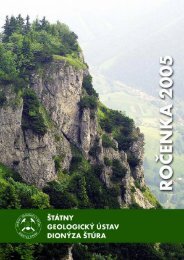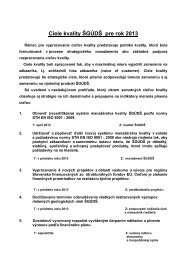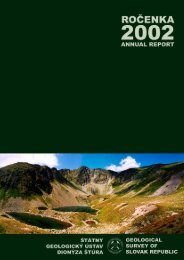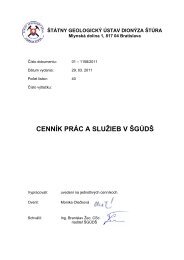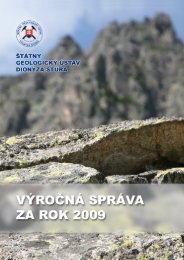Németh, Z., Plašienka, D., Šimon, L., Kohút, M - Štátny geologický ...
Németh, Z., Plašienka, D., Šimon, L., Kohút, M - Štátny geologický ...
Németh, Z., Plašienka, D., Šimon, L., Kohút, M - Štátny geologický ...
You also want an ePaper? Increase the reach of your titles
YUMPU automatically turns print PDFs into web optimized ePapers that Google loves.
8 th Annual Seminary of the Slovak Geological Society<br />
deposits of the Vienna Basin: Sphaeroma bachmayeri TAUBER, 1950<br />
and Sphaeroma weinfurteri BACHMAYER, 1947.<br />
At the Cerová-Lieskové locality (north-eastern part of the<br />
Vienna Basin) eight specimens of isopods belonging to the family<br />
Cirolanidae were recovered during the field work done by the authors<br />
in the last few years. The precise generic and specific identification<br />
of the specimens is still in progress. At the studied locality, Karpatian<br />
(latest Burdigalian) sediments of the Lakšárska Nová Ves Formation<br />
(Špička and Zapletalová, 1964) are well exposed in a former claypit.<br />
These are characterized by the offshore marine depositional facies,<br />
represented by a grey calcareous pelitic “schlier-facies”. Based on<br />
planctonic foraminifera the age of the deposits can be stated as late<br />
Karpatian (Kováčová, 2008).<br />
Fossil isopods are quite rare in the fossil record in comparison<br />
to the great diversity of living forms. When found in the fossil state<br />
they are usually poorly preserved without appendages, eyes and<br />
mouthparts, which are very important for isopod classification<br />
(Wägele, 1989; Brandt and Poore, 2003). However, several attempts<br />
to classify isopods on the basis of the morphological features of the<br />
cephalothorax or the pleotelson were made (e.g. Basso and Tintori,<br />
1994; Wilson, 1998; Polz et al., 2006).<br />
Isopod specimens from the Cerová-Lieskové locality are well<br />
preserved, so virtually all features of cephalothorax and pleotelson<br />
can be described. Moreover some of the specimens exhibit the<br />
typical pattern of biphasic moulting (Schöbl, 1880; George, 1972),<br />
in which the posterior part of the exoskeleton (pleon and posterior<br />
three pereonal somites) is always shed prior to the anterior half.<br />
The moult of the anterior part is followed within a few hours or<br />
even days, and then it usually breaks up into small fragments that<br />
would be nearly impossible to interpret in the fossil record (Wieder<br />
and Feldmann, 1992; Feldmann and Rust, 2006; Polz et al., 2006).<br />
Studied specimens show the anterior part being relatively upturned<br />
to the position of posterior part. Both parts are preserved one close<br />
to another suggesting no subsequent transport. The mode of isopod<br />
preservation at the locality suggests rather rapid burial without<br />
subsequent physical or biological disturbance. This is documented<br />
also on the rich decapod crustacean fauna, which exhibits also the<br />
preservation of delicate structures usually not present in the fossil<br />
record (Hyžný and Schlögl, submitted).<br />
The decapod association together with isopod crustaceans<br />
possess all features of a deep water assemblage.<br />
Acknowledgements. The work has been supported by the<br />
research grants APVV 0280-07 to D. Reháková, VEGA 1/4039/07,<br />
to D. <strong>Plašienka</strong> and UK/353/2009 to M. Hyžný.<br />
Fig. 1. Idealized sketch environments identified in the Upper<br />
Badenian – Sarmatian sediments of the Vienna Basin. Figure<br />
based on data compilation of Lidz et al. (1989), Murray (1991),<br />
Hayward et al. (1997), Edwards et al. (2004). Abbreviations<br />
of the foraminiferal associations: Tr – Trochammina,<br />
H – Haplophragmoides, M – Miliammina, A – Ammonia,<br />
mA – macrospherical tests of Ammonia, hspA – high spired<br />
tests of Ammonia, sM – small miliolids, E – Elphidium,<br />
P – Porosonion, Hy – Haynesina, Q – Quinqueloculina,<br />
N – Nonion, B – Bolivina, R – reworked.<br />
N. HUDÁČKOVÁ, E. HALÁSOVÁ, I. KOUBOVÁ and M.<br />
KOVÁČOVÁ: From the deep marine to shallow water<br />
paleoenvironment of the Upper Badenian to Sarmatian<br />
sediments (Slovak part of the Vienna Basin)<br />
The development of investigated intramountain Vienna Basin<br />
(Slovakia) was affected by global environmental changes as well as<br />
specific influences due to local factors, being a part of epicontinental<br />
sea called Central Paratethys. Distinctive changes occurred in the<br />
Middle Miocene. These processes caused the forming of marine and<br />
terrestrial phases in the Paratethys area with occasional connections<br />
with the Mediterranean and Eastern Paratethys. Closing and<br />
reactivating of seaways, especially during the Miocene, produced<br />
changes of environmental conditions. The Late Badenian (13.6 – 12.7<br />
Ma) is regarded as the last period of marine connection between<br />
the Paratethys and Mediterranean Tethys. Sarmatian sediments<br />
represent last normal to brackish marine sediments in the Vienna<br />
Basin. Analyses of depositional environment of the Late Badenian and<br />
Sarmatian infill of the Vienna Basin show distinct facies segmentation<br />
from sedimentological, as well as from paleontological aspects.<br />
Late Badenian sediments are represented by grey calcareous<br />
siltstones, claystones to sandstones with or without bioturbation<br />
and fragments of macrofossils. They probably represent sediments<br />
typical for stratified water column with the low oxic conditions at the<br />
bottom passing to the intertidal or deltaic environment. Marine facies<br />
of suboxic to dysoxic conditions represent B/B (Bulimina/Bolivina)<br />
changing with G (Globigerina) foraminiferal association. The distinct<br />
shallowing documented by A/P (Ammonia/Porosononion), A/E<br />
(Ammonia/Elphidium) and A/H (Ammonia/Haynesina) foraminiferal<br />
assemblages, accompanied by calcareous nannofossils dominated<br />
by small reticulofenestres, Reticulofenestra haqii and R. minuta,<br />
is documented in marginal area and passing into the Sarmatian<br />
sediments (Fig. 1). The Glyptostrobus marshes are developed also.<br />
Mentioned assemblages are typical for high energy environments of<br />
shallow, brackish water of the inner shelf, sheltered bays or deltas<br />
with the depth to 20 m and salinity under 32 %. More likely it could<br />
also represent intermediate or hyposaline marshes. Lowermost<br />
Sarmatian represents monotypic associations with Ammonia, which<br />
continued from Upper Badenian sediments. This stressed shallow<br />
water conditions, and even freshwater are changed to deeper Ab<br />
(Anomalinoides badenensis) association. Large Elphidia Zone is<br />
developed in the northern areas. In the upper portions of profiles<br />
the associations with small miliolids followed. Assemblages of small<br />
miliolids, Ammonia vienensis and Elphidium are interfingering<br />
547


